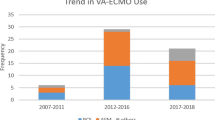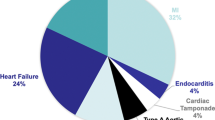Abstract
Purpose
To describe the characteristics, outcomes, and risk factors associated with poor outcome of venoarterial extracorporeal membrane oxygenation (VA-ECMO)-treated patients with refractory shock post-cardiac arrest.
Methods
We retrospectively analyzed data collected prospectively (March 2007–January 2015) in a 26-bed tertiary hospital intensive care unit. All patients implanted with VA-ECMO for refractory cardiogenic shock after successful resuscitation from cardiac arrest were included. Refractory cardiac arrest patients, given VA-ECMO under cardiopulmonary resuscitation, were excluded.
Results
Ninety-four patients received VA-ECMO for refractory shock post-cardiac arrest. Their hospital and 12-month survival rates were 28 and 27 %, respectively. All 1-year survivors were cerebral performance category 1. Multivariable analysis retained INR >2.4 (OR 4.9; 95 % CI 1.4–17.2), admission SOFA score >14 (OR 5.3; 95 % CI 1.7–16.5), and shockable rhythm (OR 0.3; 95 % CI 0.1–0.9) as independent predictors of hospital mortality, but not SAPS II, out-of-hospital cardiac arrest score, or other cardiac arrest variables. Only 10 % of patients with an admission SOFA score >14 survived, whereas 50 % of those with scores ≤14 were alive at 1 year. Restricting the analysis to the 67 patients with out-of-hospital cardiac arrest of coronary cause yielded similar results.
Conclusion
Among 94 patients implanted with VA-ECMO for refractory cardiogenic shock post-cardiac arrest resuscitation, the 24 (27 %) 1-year survivors had good neurological outcomes, but survival was significantly better for patients with admission SOFA scores <14, shockable rhythm, and INR ≤2.4. VA-ECMO might be considered a rescue therapy for patients with refractory cardiogenic shock post-cardiac arrest resuscitation.



Similar content being viewed by others
Change history
17 October 2017
The second element of the first author’s name was misinterpreted as a given name, whereas in fact it is part of his family name. The correct version of his name for indexing purposes is therefore M. Pineton de Chambrun (not M. P. de Chambrun).
References
Donnino MW, Miller JC, Bivens M et al (2012) A pilot study examining the severity and outcome of the post-cardiac arrest syndrome: a comparative analysis of two geographically distinct hospitals. Circulation 126:1478–1483. doi:10.1161/CIRCULATIONAHA.111.067256
Adrie C, Cariou A, Mourvillier B et al (2006) Predicting survival with good neurological recovery at hospital admission after successful resuscitation of out-of-hospital cardiac arrest: the OHCA score. Eur Heart J 27:2840–2845. doi:10.1093/eurheartj/ehl335
Girotra S, Nallamothu BK, Spertus JA et al (2012) Trends in survival after in-hospital cardiac arrest. N Engl J Med 367:1912–1920. doi:10.1056/NEJMoa1109148
Eisenberg MS, Mengert TJ (2001) Cardiac resuscitation. N Engl J Med 344:1304–1313. doi:10.1056/NEJM200104263441707
Bunch TJ, White RD, Gersh BJ et al (2003) Long-term outcomes of out-of-hospital cardiac arrest after successful early defibrillation. N Engl J Med 348:2626–2633. doi:10.1056/NEJMoa023053
Bernard SA, Gray TW, Buist MD et al (2002) Treatment of comatose survivors of out-of-hospital cardiac arrest with induced hypothermia. N Engl J Med 346:557–563. doi:10.1056/NEJMoa003289
Hypothermia after Cardiac Arrest Study Group (2002) Mild therapeutic hypothermia to improve the neurologic outcome after cardiac arrest. N Engl J Med 346:549–556. doi:10.1056/NEJMoa012689
Bougouin W, Lamhaut L, Marijon E et al (2014) Characteristics and prognosis of sudden cardiac death in Greater Paris. Intensive Care Med 40:846–854. doi:10.1007/s00134-014-3270-3
Citerio G, Bakker J, Bassetti M et al (2015) Year in review in Intensive Care Medicine 2014: I. Cardiac dysfunction and cardiac arrest, ultrasound, neurocritical care, ICU-acquired weakness, nutrition, acute kidney injury, and miscellaneous. Intensive Care Med 41:179–191. doi:10.1007/s00134-015-3665-9
Paul M, Bougouin W, Geri G et al (2016) Delayed awakening after cardiac arrest: prevalence and risk factors in the Parisian registry. Intensive Care Med 42:1128–1136. doi:10.1007/s00134-016-4349-9
Mongardon N, Dumas F, Ricome S et al (2011) Postcardiac arrest syndrome: from immediate resuscitation to long-term outcome. Ann Intensive Care 1:45. doi:10.1186/2110-5820-1-45
Nolan JP, Neumar RW, Adrie C et al (2008) Post-cardiac arrest syndrome: epidemiology, pathophysiology, treatment, and prognostication. A Scientific Statement from the International Liaison Committee on Resuscitation; the American Heart Association Emergency Cardiovascular Care Committee; the Council on Cardiovascular Surgery and Anesthesia; the Council on Cardiopulmonary, Perioperative, and Critical Care; the Council on Clinical Cardiology; the Council on Stroke. Resuscitation 79:350–379. doi:10.1016/j.resuscitation.2008.09.017
Perner A, Citerio G, Bakker J et al (2015) Year in review in Intensive Care Medicine 2014: II. ARDS, airway management, ventilation, adjuvants in sepsis, hepatic failure, symptoms assessment and management, palliative care and support for families, prognostication, organ donation, outcome, organisation and research methodology. Intensive Care Med 41:389–401. doi:10.1007/s00134-015-3707-3
Timsit J-F, Perner A, Bakker J et al (2015) Year in review in Intensive Care Medicine 2014: III. Severe infections, septic shock, healthcare-associated infections, highly resistant bacteria, invasive fungal infections, severe viral infections, Ebola virus disease and paediatrics. Intensive Care Med 41:575–588. doi:10.1007/s00134-015-3755-8
Schmidt M, Burrell A, Roberts L et al (2015) Predicting survival after ECMO for refractory cardiogenic shock: the survival after veno-arterial-ECMO (SAVE)-score. Eur Heart J 36:2246–2256. doi:10.1093/eurheartj/ehv194
Mirabel M, Luyt C-E, Leprince P et al (2011) Outcomes, long-term quality of life, and psychologic assessment of fulminant myocarditis patients rescued by mechanical circulatory support. Crit Care Med 39:1029–1035. doi:10.1097/CCM.0b013e31820ead45
Combes A, Leprince P, Luyt C-E et al (2008) Outcomes and long-term quality-of-life of patients supported by extracorporeal membrane oxygenation for refractory cardiogenic shock. Crit Care Med 36:1404–1411. doi:10.1097/CCM.0b013e31816f7cf7
Le Guen M, Nicolas-Robin A, Carreira S et al (2011) Extracorporeal life support following out-of-hospital refractory cardiac arrest. Crit Care 15:R29. doi:10.1186/cc9976
Abrams D, Combes A, Brodie D (2014) What’s new in extracorporeal membrane oxygenation for cardiac failure and cardiac arrest in adults? Intensive Care Med 40:609–612. doi:10.1007/s00134-014-3212-0
Xie A, Phan K, Tsai Y-C et al (2015) Venoarterial extracorporeal membrane oxygenation for cardiogenic shock and cardiac arrest: a meta-analysis. J Cardiothorac Vasc Anesth 29:637–645. doi:10.1053/j.jvca.2014.09.005
Aissaoui N, Luyt C-E, Leprince P et al (2011) Predictors of successful extracorporeal membrane oxygenation (ECMO) weaning after assistance for refractory cardiogenic shock. Intensive Care Med 37:1738–1745. doi:10.1007/s00134-011-2358-2
Beurtheret S, Mordant P, Paoletti X et al (2013) Emergency circulatory support in refractory cardiogenic shock patients in remote institutions: a pilot study (the cardiac-RESCUE program). Eur Heart J 34:112–120. doi:10.1093/eurheartj/ehs081
Luyt CE, Bréchot N, Demondion P et al (2016) Brain injury during venovenous extracorporeal membrane oxygenation. Intensive Care Med 42:897–907. doi:10.1007/s00134-016-4318-3
Rittenberger JC, Raina K, Holm MB et al (2011) Association between cerebral performance category, modified rankin scale, and discharge disposition after cardiac arrest. Resuscitation 82:1036–1040. doi:10.1016/j.resuscitation.2011.03.034
Laver S, Farrow C, Turner D, Nolan J (2004) Mode of death after admission to an intensive care unit following cardiac arrest. Intensive Care Med 30:2126–2128. doi:10.1007/s00134-004-2425-z
Laurent I, Monchi M, Chiche J-D et al (2002) Reversible myocardial dysfunction in survivors of out-of-hospital cardiac arrest. J Am Coll Cardiol 40:2110–2116
Lemiale V, Dumas F, Mongardon N et al (2013) Intensive care unit mortality after cardiac arrest: the relative contribution of shock and brain injury in a large cohort. Intensive Care Med 39:1972–1980. doi:10.1007/s00134-013-3043-4
Ruiz-Bailén M, Aguayo de Hoyos E, Ruiz-Navarro S et al (2005) Reversible myocardial dysfunction after cardiopulmonary resuscitation. Resuscitation 66:175–181. doi:10.1016/j.resuscitation.2005.01.012
Thiele H, Zeymer U, Neumann F-J et al (2012) Intraaortic balloon support for myocardial infarction with cardiogenic shock. N Engl J Med 367:1287–1296. doi:10.1056/NEJMoa1208410
Manzo-Silberman S, Fichet J, Mathonnet A et al (2013) Percutaneous left ventricular assistance in post cardiac arrest shock: comparison of intra aortic blood pump and Impella Recover LP2.5. Resuscitation 84:609–615. doi:10.1016/j.resuscitation.2012.10.001
Mukku VK, Cai Q, Gilani S et al (2012) Use of impella ventricular assist device in patients with severe coronary artery disease presenting with cardiac arrest. Int J Angiol 21:163–166. doi:10.1055/s-0032-1324736
Muller G, Flecher E, Lebreton G et al (2016) The ENCOURAGE mortality risk score and analysis of long-term outcomes after VA-ECMO for acute myocardial infarction with cardiogenic shock. Intensive Care Med 42:370–378. doi:10.1007/s00134-016-4223-9
Author information
Authors and Affiliations
Corresponding author
Ethics declarations
Conflicts of interest
Dr. Combes is the primary investigator of the EOLIA trial (NCT01470703), a randomized trial of VV-ECMO, supported in part by MAQUET. Drs. Bréchot, Lebreton, and Combes have received honoraria for lectures from MAQUET. The other authors declare that they have no conflicts of interest related to the purpose of this manuscript.
Additional information
Take-home message: Refractory cardiogenic shock is one of the leading causes of early death after successful cardiac arrest resuscitation. In this setting, venoarterial extracorporeal membrane oxygenation is associated with 27 % 1-year survival. Patients with SOFA scores >14 have poorer outcomes than the others (respective survival 10 vs. 50 %), raising the question of futility in these patients.
A correction to this article is available online at https://doi.org/10.1007/s00134-017-4963-1.
Electronic supplementary material
Below is the link to the electronic supplementary material.
Rights and permissions
About this article
Cite this article
de Chambrun, M.P., Bréchot, N., Lebreton, G. et al. Venoarterial extracorporeal membrane oxygenation for refractory cardiogenic shock post-cardiac arrest. Intensive Care Med 42, 1999–2007 (2016). https://doi.org/10.1007/s00134-016-4541-y
Received:
Accepted:
Published:
Issue Date:
DOI: https://doi.org/10.1007/s00134-016-4541-y




